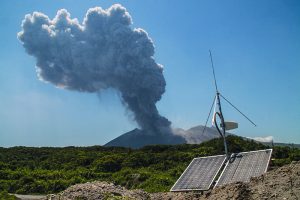 In the one hundred years since AGU was founded in 1919, the field of Earth and space science – often influenced by large-scale geopolitical events and technological innovation – has advanced by leaps and bounds.
In the one hundred years since AGU was founded in 1919, the field of Earth and space science – often influenced by large-scale geopolitical events and technological innovation – has advanced by leaps and bounds.
The period between the end of World War I in 1918 and the start of the hostilities of World War II (1939) was particularly fruitful:
- In 1926, Robert Goddard became the first person to launch a liquid-fuel rocket
- In 1930, Clyde Tombaugh discovered Pluto, a new planet predicted 25 years earlier by Percival Lowell, and seismologist Inge Lehmann, discovered Earth's inner core; and
- In 1935 Charles Richter developed the Richter magnitude scale as a mathematical device to compare the size of earthquakes
As global tensions arose with the advent of the Cold War in 1947, scientific study continued unabated and the space race began in earnest:
- The first International Geophysical Year was proclaimed in 1957, the same year Sputnik I was successfully launched by the Soviet Union
- In 1964, the deep-sea submersible Alvin – capable of diving to 13,000 feet – is launched
- In 1969, in an event that was once only science-fiction, Apollo 11 astronauts Neil Armstrong and Buzz Aldrin walk on the moon
After the moon landing, atmospheric research, and in particular the depletion of the ozone layer, received renewed attention.
- In 1981, NASA reported satellite evidence that the stratospheric ozone layer was being depleted globally
- Eight years later, in 1989, the Montreal Protocol to phase out stratospheric ozone-destroying chlorofluorocarbons went into effect
With the dawning of the new millennium, researchers employed even more powerful tools and technologies to chart the heavens and track threats posed by natural disasters and anthropogenic climate change.
- The Hubble Space Telescope – named after astronomer Edwin Hubble who first discovered galaxies beyond our own 66 years earlier - was launched into orbit in 1990
- In 2013, NASA landed the Curiosity rover on our nearest celestial neighbor, Mars
- A year later, in 2014, the European Space Agency’s Philae lander touched down on the Churyumov–Gerasimenko comet
- In 2017, a Delaware size iced shelf collapsed off of the Larsen C Ice Shelf in Antarctica.
Clearly, the scientific achievements that were needed to overcome the challenges our global society experience over the last century demanded innovation, creativity, and cooperative effort – all things in which the Earth and space science community excels. AGU’s Centennial is about using that energy to advance the next century of Earth and space science for the benefit of humanity.

